![]()
| T & R Boote |
Location and period of operation:
|
T
& R Boote |
Burslem |
1842
|
1963 |
|
Earthenware, Parian ware, tile manufacturer - originally at the Central Pottery, Burslem, Stoke-on-Trent.
Types of ware manufactured:
|
jump to:
Domestic, useful and decorative ware
"Messrs. T. & R. Boote, of Burslem, have very courteously supplied the following particulars relative to their establishment:- The firm was founded early in 1842 by Messrs. Thomas Latham Boote and Richard Boote, who commenced at the Central Pottery, Burslem, their original manufacture being Parian statuary and vases, of which a display was made in the first International Exhibition of 1851, and a prize medal awarded. The exhibit attracted, amongst others, the Prince Frederick William of Prussia (afterward the Emperor Frederick of Germany), who made a purchase. After a few years the Central Pottery was found too small, and the Kilncroft Works was occupied. Ultimately, about the year 1850 the various works on the site of what is now called the Waterloo Potteries were purchased and occupied by Messrs. T. & R. Boote.
About the same time the manufacture of tiles, which had then been revived by Messrs. Minton, Hollins & Co., of Stoke-on-Trent, attracted the attention of Messrs. Boote, and they secured the premises on the west side of Waterloo Road, Burslem and there commenced a business which has grown to its present dimensions.
From time to time changes were made, and between the years 1850 and 1860 the manufacture of white earthenware (called white granite) was undertaken for the American market, the firm suffering very considerably, along with many others, during the American Civil War.
In September 1879 Mr. T. L. Boote retired from the firm, which passed solely into the hands of Mr. Richard Boote, who at that time, and until his death in 1891, was ably assisted in the management by his son Mr. Albert J. T. Boote, and later by his second son Mr. Richard Latham Boote, who, in conjunction with his brother Mr. Charles Edmund Boote, still controls the business, which since 1894 has been conducted as a private limited liability concern.
Prize medals were awarded at the London Exhibition of 1861 and the Calcutta Exhibition of 1883. The Blackwall Tunnel is one of the public works that have been tiles throughout by this firm"
Leadless decorative tiles, faience and mosaic - William James Furnival - 1904
London Gazette
March 26, 1861
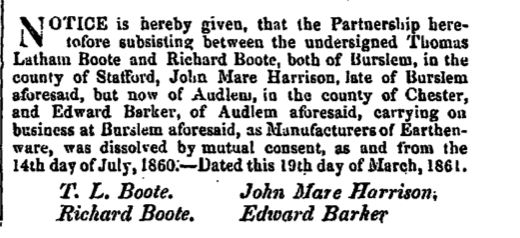
notice of the dissolution of the Partnership as earthenware manufacturers
between Thomas Latham Boote and Richard Boote,
John Mare Harrison and Edward Barker
London Gazette
August 16, 1861
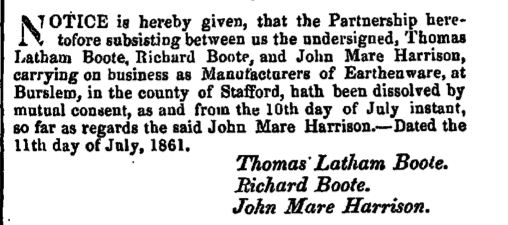
notice that John Mare Harrison left the business, which
was continued by Thomas Latham Boote and Richard Boote
London Gazette
September 19, 1879
notice of the retirement of Thomas Latham Boote,
the business was continued by Richard Boote
Domestic, useful and decorative ware
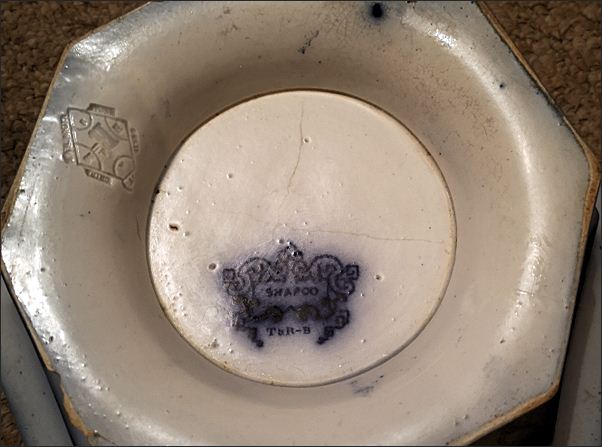 printed Shapoo mark with an impressed registration diamond |
 T&R Boote Stone China the registration diamond shows that the pattern was registered on the 26th April 1845 |
photos courtesy: Janet McKenzie
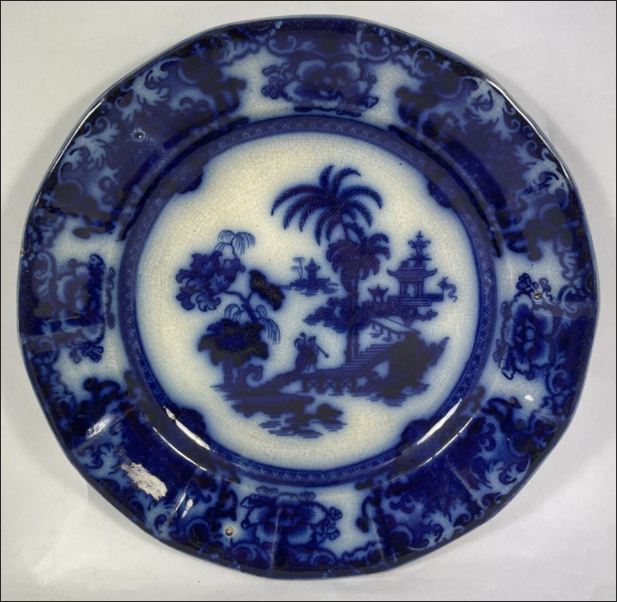 flow-blue plate in the Shapoo pattern
|
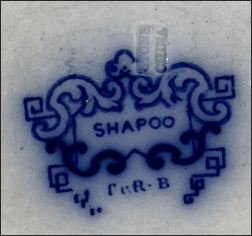 Shapoo T & R B
STONE CHINA
|
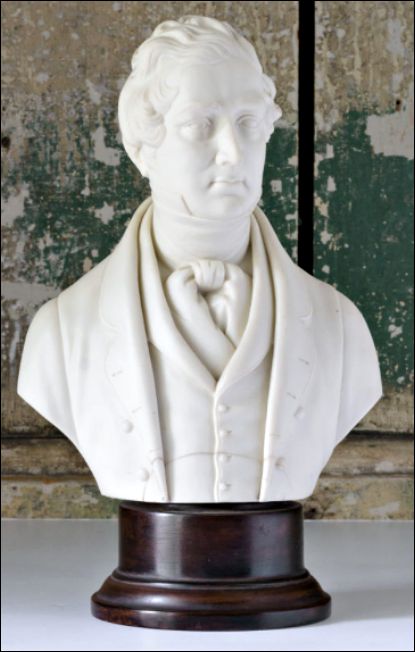 Parian ware bust of Sir Robert Peel Sir Robert Peel (1788-1850), was a British Conservative statesman who twice was Prime Minister of the United Kingdom - Peel was a patron of the portrait painter Thomas Lawrence |
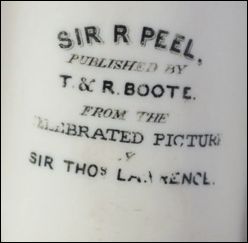 Sir R Peel published by T & R Boote from the celebrated picture by Sir Thos Lawrence
|
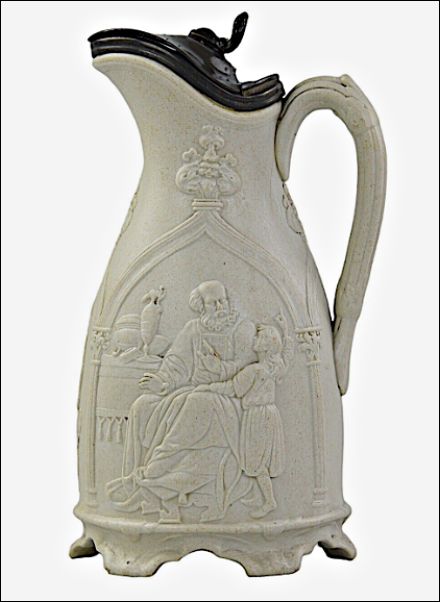 T & R Boote relief moulded jug - Samuel and Eli
|
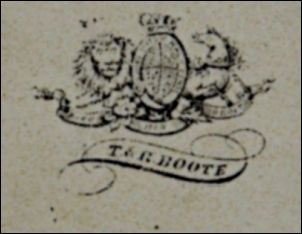 T & R Boote Printed mark which includes the Royal Arms - sometimes the makers name, T & R Boote, is not included. On some jugs in this design a registration diamond is printed which shows that the design was registered on the 17th October 1848 |
Patent Mosaic
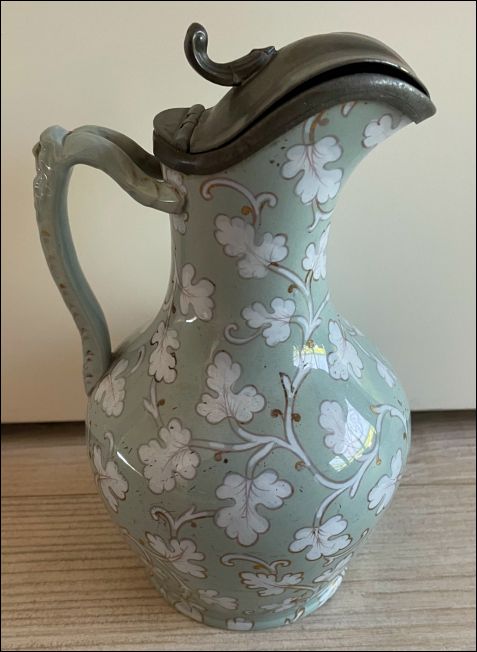 moulded jug with Britannia metal lid The patent referred to in the mark is Richard Boote's patent of 1843 for "Improvements in Pottery and Mosaic Work". This covered four different processes including one for manufacturing wares with coloured grounds, and another for inlaying designs into the ware's surface. The latter was used extensively by Boote and this
jug is a fairly typical example. They occur with differing designs and in various colours. Ref: Dick Henrywood |
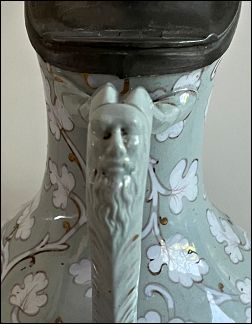
|
photos courtesy: Hilde Tuk
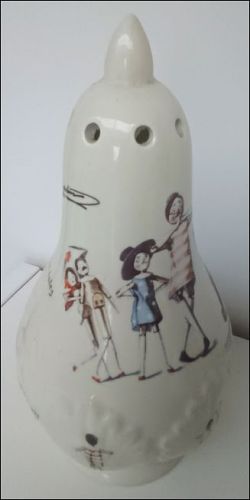 |
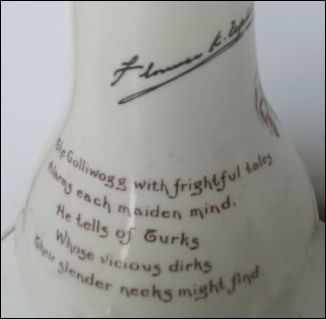 The Golliwogg with frightful tales Alarms each maiden mind. He tells of Turks Whose vicious dirks Their slender necks might find From around 1895 to 1906 T & R Boote produced a range of tableware with designs based on one of the Florence Kate Upton books showing the typical "penny wooden" dolls featured in her stories. |
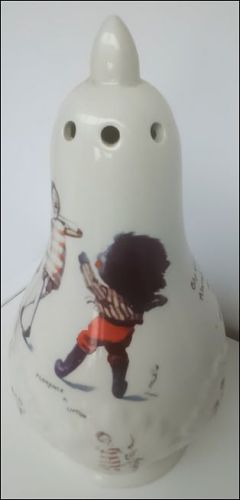 |
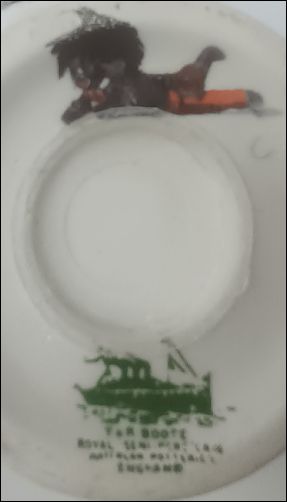 T. & R. Boote Royal Semi-Porcelain Waterloo Potteries England the Waterloo Pottery closed in 1906 |
photos courtesy: Sandra Ison
Marks
and initials
used on domestic & decorative ware for identification:
T & R B
T & R BOOTE
T B & S
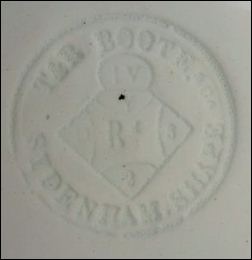 T & R Boote Sydenham Shape The registration diamond shows that a dinner set design was registered on 3rd September 1853 to T and R Boote, Waterloo Potteries and Encaustic Tile Works, Burslem, Staffordshire. |
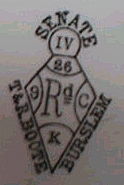 Senate T & R Boote Burslem SENATE is the pattern name The registration
diamond shows that the design was registered on 26th November 1870
to |
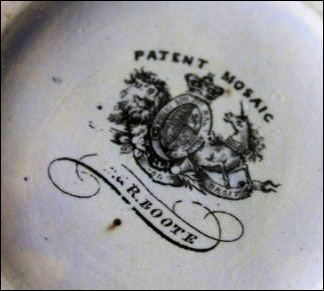
Patent Mosaic T & R Boote |
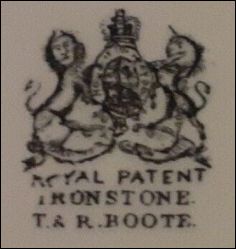 Royal Patent Ironstone T & R Boote |
The Royal
Arms were sometimes included
in Boote's Victorian marks
|
Lahore is the pattern name The
registration diamond shows the pattern was registered on the |
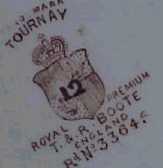 Trade Mark Royal Premium T. & R. Boote England Tournay is the pattern name The registration number 33645 shows the pattern was registered on the 18th September 1885 |
 Royal Premium T. & R. Boote England Burmah is the pattern name The registration number 51430 shows the pattern was registered on the 26th June 1886 |
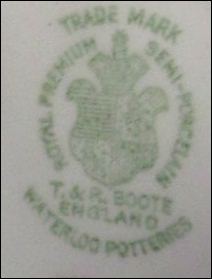
Trade Mark
Royal Premium
Semi-Porcelain
T. & R. Boote
England
Waterloo Potteries
the Waterloo Pottery was closed in 1906
|
"W.G." probably stands for White Granite |
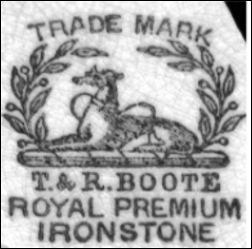 T. & R. Boote Royal Premium Ironstone |
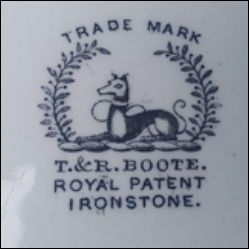 T. & R. Boote Royal Patent Ironstone |
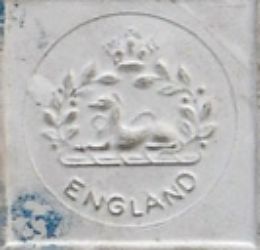
mark on T&R Boote tile |
the Irish Wolfhound mark was used on dinner ware and tiles
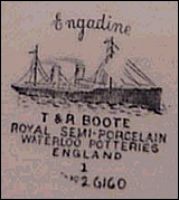
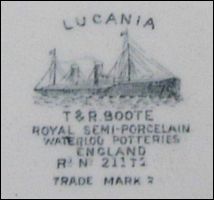
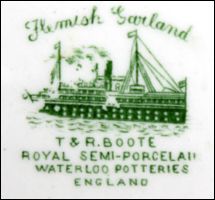
T. & R. Boote
Royal Semi-Porcelain
Waterloo Potteries
England
the Waterloo Pottery was closed in 1906
Tile manufacture
|
As well as producing Parian statuary and earthenware for domestic use, T & R Boote specialised in tile production. By 1850 the company had begun producing tiles. Their range included both functional tiles used in architectural applications (such as fireplaces, walls, and floors) and more decorative items that often featured intricate designs. They were noted for patenting the “pressed dust” process. This innovative method allowed them to mass produce utilitarian tiles while maintaining a high standard of decorative quality. Boote also produced transfer printed and majolica tiles, some of which were hand-painted - these designs reflected elements of the Aesthetic Movement and Art Nouveau. In 1906 the Waterloo works were closed and production concentrated on tile manufacture. |
T and R Boote
The Patent Tile Works, Burslem, StaffordshireThe Pottery Gazette, American and Canadian Edition, January 1st 1880
T and R Boote Limited
Encaustic & Glazed Tile Manufacturers
Burslem, StaffordshireJuly 1898
T & R Boote Limited
Patent Tile Works - Waterloo Potteries & Glazed Tile Works - Newport Lane Works
Manufacturers of Encaustic, Mosaic and Plain Flooring Tiles,
Glazed Wall Tiles, Printed, Painted and Majolica Tiles, White,
Glazed and Tinted Tiles, Slabbed Hearths and JambsSupplement to The Ironmonger, March 25th 1899
Courtesy: robmcrorie, flickr
Boote's Tiles
The Patent Tile Works
Burslem England
- selections of the newest designs for tiling made by T. & R. Boote (c. 1906) -
a selection of T & R Boote tilesCourtesy: robmcrorie, flickr
rear of the tiles
 |
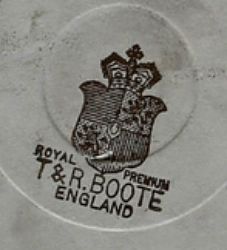 |
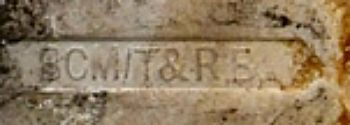 BCM/T&RB British Commercial Monomarks was a postbox service launched in November 1925 the initials BCM were to be used on goods along with an identifying name to uniquely identify the manufacturer and provide a method of correspondence. |
a particularly fine example of T and R Boote tiles installed in the front porch of a house
in Burslem, Stoke-on-Trent
the hallway of the same housephotos courtesy: Nicola Hill
click for
further information on T
& R Boote Works:
Questions, comments, contributions? email: Steve Birks